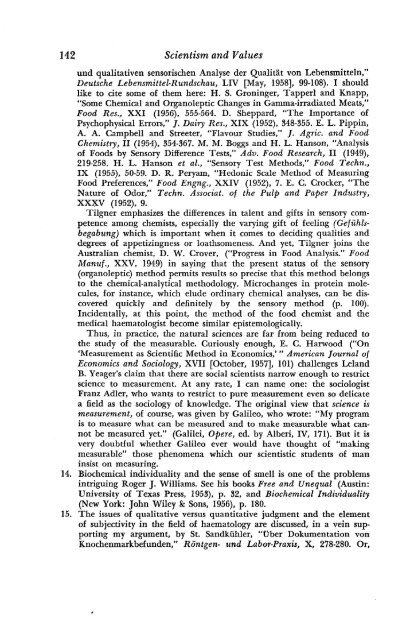Scientism and Values.pdf - Ludwig von Mises Institute
Scientism and Values.pdf - Ludwig von Mises Institute
Scientism and Values.pdf - Ludwig von Mises Institute
Create successful ePaper yourself
Turn your PDF publications into a flip-book with our unique Google optimized e-Paper software.
142 <strong>Scientism</strong> <strong>and</strong> <strong>Values</strong><br />
und qualitativen sensorischen Analyse der Qualitat <strong>von</strong> Lebensmitteln,"<br />
Deutsche Lebensmittel-Rundschau, LIV [May, 1958], 99-108). I should<br />
like to cite some of them here: H. S. Groninger, Tapper! <strong>and</strong> Knapp,<br />
"Some Chemical <strong>and</strong> Organoleptic Changes in Gamma-irradiated Meats,"<br />
Food Res., XXI (1956), 555-564. D. Sheppard, "The Importance of<br />
Psychophysical Errors," J. Dairy Res., XIX (1952), 348-355. E. L. Pippin,<br />
A. A. Campbell <strong>and</strong> Streeter, "Flavour Studies," J. Agric. <strong>and</strong> Food<br />
Chemistry, II (1954), 354-367. M. M. Boggs <strong>and</strong> H. L. Hanson, "Analysis<br />
of Foods by Sensory Difference Tests," Adv. Food Research, II (1949),<br />
219-258. H. L. Hanson et al., "Sensory Test Methods," Food Techn.,<br />
IX (1955), 50-59. D. R. Peryam, "Hedonic Scale Method of Measuring<br />
Food Preferences," Food Engng., XXIV (1952), 7. E. C. Crocker, "The<br />
Nature of Odor," Techn. Associat. of the Pulp <strong>and</strong> Paper Industry,<br />
XXXV (1952), 9.<br />
Tilgner emphasizes the differences in talent <strong>and</strong> gifts in sensory competence<br />
among chemists, especially the varying gift of feeling (Gefilhlsbegabung)<br />
which is important when it comes to deciding qualities <strong>and</strong><br />
degrees of appetizingness or loathsomeness. And yet, Tilgner joins the<br />
Australian chemist, D. W. Crover, ("Progress in Food Analysis." Food<br />
Manuf., XXV, 1949) in saying that the present status of the sensory<br />
(organoleptic) method permits results so precise that this method belongs<br />
to the chemical-analytical methodology. Microchanges in protein molecules,<br />
for instance, which elude ordinary chemical analyses, can be discovered<br />
quickly <strong>and</strong> definitely by the sensory method (p. 100).<br />
Incidentally, at this point, the method of the food chemist <strong>and</strong> the<br />
medical haematologist become similar epistemologically.<br />
Thus, in practice, the natural sciences are far from being reduced to<br />
the study of the measurable. Curiously enough, E. C. Harwood ("On<br />
'Measurement as Scientific Method in Economics,''' American Journal of<br />
Economics <strong>and</strong> Sociology, XVII [October, 1957], 101) challenges Lel<strong>and</strong><br />
B. Yeager's claim that there are social scientists narrow enough to restrict<br />
science to measurement. At any rate, I can name one: the sociologist<br />
Franz Adler, who wants to restrict to pure measurement even so delicate<br />
a field as the sociology of knowledge. The original view that science is<br />
measurement, of course, was given by Galileo, who wrote: "My program<br />
is to measure what can be measured <strong>and</strong> to make measurable what cannot<br />
be measured yet." (Galilei, Opere, ed. by Alberi, IV, 171). But it is<br />
very doubtful whether Galileo ever would have thought of "making<br />
measurable" those phenomena which our scientistic students of man<br />
insist on measuring.<br />
14. Biochemical individuality <strong>and</strong> the sense of smell is one of the problems<br />
intriguing Roger J. Williams. See his books Free <strong>and</strong> Unequal (Austin:<br />
University of Texas Press, 1953), p. 32, <strong>and</strong> Biochemical Individuality<br />
(New York: John Wiley & Sons, 1956), p. 180.<br />
15. The issues of qualitative versus quantitative judgment <strong>and</strong> the element<br />
of subjectivity in the field of haematology are discussed, in a vein supporting<br />
my argument, by St. S<strong>and</strong>kiihler, "tiber Dokumentation <strong>von</strong><br />
Knochenmarkbefunden," Rontgen- und Labor-Praxis, X, 278-280. Or,
















